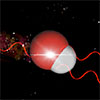| Apr 07, 2022 |
|
|
|
(Nanowerk News) A powerful radio-wave laser, called a ‘megamaser’, has been observed by the MeerKAT telescope in South Africa.
|
|
The record-breaking find is the most distant megamaser of its kind ever detected, at about five billion light years from Earth.
|
|
The light from the megamaser has travelled 58 thousand billion billion (58 followed by 21 zeros) kilometres to Earth.
|
The discovery was made by an international team of astronomers led by Dr Marcin Glowacki, who previously worked at the Inter-University Institute for Data Intensive Astronomy and the University of the Western Cape in South Africa (The Astrophysical Journal Letters, “LADUMA: Discovery of a luminous OH megamaser at z>0.5
“).
|
 |
| Artist’s impression of a hydroxyl maser. Inside a galaxy merger are hydroxyl molecules, composed of one atom of hydrogen and one atom of oxygen. When one molecule absorbs a photon at 18cm wavelength, it emits two photons of the same wavelength. When molecular gas is very dense, typically when two galaxies merge, this emission gets very bright and can be detected by radio telescopes such as the MeerKAT. (Image: IDIA/LADUMA using data from NASA/StSci/SKAO/MolView)
|
|
Dr Glowacki, who is now based at the Curtin University node of the International Centre for Radio Astronomy Research (ICRAR) in Western Australia, said megamasers are usually created when two galaxies violently collide in the Universe.
|
|
“When galaxies collide, the gas they contain becomes extremely dense and can trigger concentrated beams of light to shoot out,” he said.
|
|
“This is the first hydroxyl megamaser to be observed by MeerKAT and the most distant seen by any telescope to date.
|
|
“It’s impressive that, with just a single night of observations, we’ve already found a record-breaking megamaser. It shows just how good the telescope is.”
|
|
The record-breaking object was named ‘Nkalakatha’ [pronounced ng-kuh-la-kuh-tah]—an isiZulu word meaning “big boss”.
|
|
Dr Glowacki said the megamaser was detected on the first night of a survey involving more than 3000 hours of observations by the MeerKAT telescope.
|
|
The team is using MeerKAT to observe narrow regions of the sky extremely deeply and will measure atomic hydrogen in galaxies from the distant past to now. The combination of studying hydroxl masers and hydrogen will help astronomers better understand how the Universe has evolved over time.
|
|
“We have follow-up observations of the megamaser planned and hope to make many more discoveries,” Dr Glowacki said.
|
|
MeerKAT is a precursor instrument for the Square Kilometre Array—a global initiative to build the world’s largest radio telescopes in Western Australia and South Africa.
|


